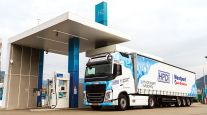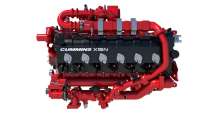Propane Fuel Use Rising, Experts Say, But Still Not Offered for Class 8 Trucks
This story appears in the July 29 print edition of Transport Topics.
What transportation fuel is America’s third most popular after gasoline and diesel? It’s not natural gas.
Actually, it’s the same fuel Americans typically use for their backyard grills: propane.
The Propane Education and Research Council counts between 135,000 and 140,000 propane-powered vehicles on American roads today, mostly in fleets such as school buses. About 10,000 propane vehicles of all types were sold last year.
That’s how it’s the world’s third most popular transportation fuel, according to PERC.
However, no original equipment manufacturer anywhere produces a propane-powered Class 8 vehicle for long-distance hauling — and for a variety of reasons, no one is likely to start building them in the immediate future.
One reason, said Bret Chandler, managing director of Propane Fuel Technologies, an investment group in Charleston, W.Va., is that the fuel traditionally has been unable to deliver the power produced by a diesel engine.
“Propane does not provide the torque of a diesel. Actually, there’s no alternative fuel out there that has the torque of a diesel,” he said.
Three parts carbon and eight parts hydrogen, propane is one of the byproducts of natural-gas processing and crude-oil refining. Most of America’s propane supply is produced domestically and has been exported since 2011.
Propane can be used in bi-fuel vehicles equipped with two tanks that allow the fuel source to be switched from gasoline to propane while the vehicle is traveling.
Typically used as a vapor in the past, propane increasingly is being used as a liquid known as liquefied petroleum gas or propane autogas.
While propane has yet to find a toehold in the Class 8 market, Freightliner Custom Chassis Corp., Gaffney, S.C., is beginning pre-series production on its S2G — a propane autogas-injected Class 7 truck with a gross vehicle rating weight of 33,000 pounds. While the truck initially will be produced for propane delivery applications, it also can be used for box truck, flatbed, beverage delivery and other operations.
A version also has been designed that will be installed in Thomas Built Buses, another sister company of Freightliner.
Bryan Henke, FCCC’s manager of product marketing, and Gordie Taylor, product manager of commercial vehicles, said the company’s project was funded with help from a grant by PERC and involved a partnership with two other companies: liquefied petroleum gas fuel-injection maker Cleanfuel USA and engine and drivetrain manufacturer Powertrain Integration.
Henke said there will be demand for the vehicle, particularly because it will be factory manufactured, installed and supported, rather than converted for propane use. Clients, he said, “don’t want to have to go to 15 different locations to get the vehicle worked on, so it’s a one-stop shop. That’s critical.”
He said asking the engine to power a vehicle heavier than 33,000 pounds gross vehicle weight with propane would affect performance, making
it difficult to redesign to fit Class 8 trucks. However, there is more activity in the medium-duty market.
Meanwhile, Liberator Engine Co., Fletcher, N.C., says its new 6-liter engine, now going through the emissions certification process with the U.S. Environmental Protection Agency, is capable of running on propane autogas, compressed natural gas, liquefied natural gas and biomethane.
Brendan Neville, Liberator’s chief operating officer, said the engine is capable of running at 1,800 rpm and producing 630 pound-feet of torque. He said it will be capable of diesel-level power because it is supercharged and, unlike previous propane engines, it was modeled after diesel engines rather than a gasoline platform.
“We’re equivalent to a diesel in terms of all the good stuff, [and] we . . . have much lower emissions,” he said.
According to Ford’s website, the comparable 6-liter Power Stroke diesel produces 560 pound-feet of torque at 2,000 rpm. Ford says this is the best for trucks weighing more than 8,500 pounds.
Neville said the engine will be released in the fourth quarter of this year. Bobtails that deliver propane will be the initial target market. The engine is capable of powering Class 7 vehicles up to 33,000 pounds gross vehicle weight, but its size can be increased to a 9-liter version using current technology and to an even larger size with modifications.
“We’re in discussions with PERC of developing the next engine, and we will go up in size,” he said. “Now, we haven’t decided yet what it’s going to be, but there’s a wide open market of the larger displacements with our technology. Propane has never been able to reach that height before, but we believe that our technology will scale, and we can take it to a bigger engine.”
More propane vehicles will be available in the future. Michael Taylor, PERC’s director for autogas business development, said that propane advocates focus for now on centralized fleets, including package deliverers, regional carriers and school buses — where range anxiety isn’t a problem and where custom fueling infrastructure can be added quickly and cost-effectively.
Another scenario for propane in big rigs may be its use as a supplemental fuel. Propane Fuel Technologies owns the exclusive North American agreement to distribute the German-engineered CHM Trucktec direct propane injection system. The system, which blends diesel with a maximum of 28% propane, has been used in Germany for five years, Chandler said.
The technology has been for sale in America since January, but Chandler said it takes a long time to move from sales lead to close. Contacted June 6, he said he had installed five systems but was talking to some major fleets.
“We believe that we’re just really in an education phase as much as a ‘trying to sell’ phase because people in this part of the country have only heard of CNG,” he said.
While no original equipment manufacturer offers propane-powered passenger cars and pickups off the assembly line, that’s a target for the industry in the future. For example, Ford F series pickups and super-duty trucks are available through Roush Clean Tech, a Ford-approved vehicle modifier in Livonia, Mich., that can convert the engine to use propane.
To convert a Ford F-150 truck to propane requires installing a 30-gallon tank under the tool-box, he said. Converting to CNG requires half the bed, Chandler said.
Discovered in 1912, propane became popular in the 1970s and 1980s before the price of gasoline and diesel dropped. The U.S. Department of Energy said it accounts for 2% of the nation’s energy use — mostly for heating and cooking.
It has a higher octane rating and is cleaner than gasoline, which leads to lower maintenance costs and a longer service life. It’s nontoxic and isn’t a threat to soil or water, according to DOE. However, the department said it has a lower Btu rating, which means it provides 15% to 25% less fuel economy than gasoline.
Nevertheless, a 2009 DOE press release stated that Schwan’s Home Service’s propane trucks have logged more than 2 billion miles since the late 1970s. As of 2009, the frozen-food delivery company operated more than 4,500 propane-fueled vehicles in the continental United States, about 75% of its fleet, DOE said.
Jeff Schueller, fleet maintenance director for Schwan’s Home Service, Marshall, Minn., confirmed the DOE numbers.
Schueller said Marvin Schwan, the company’s founder, “first pursued propane-powered trucks in the 1970s, when the country was experiencing high gasoline prices and oil embargoes. He originally saw it as a way to ensure a reliable fuel source. As we gained experience, we grew to learn of other benefits of using propane.”
Citing its “more obvious benefits,” Schueller said, “it burns more cleanly than traditional fossil fuels, reducing our environmental impact. There’s an abundant supply, [and] propane is typically less expensive than gasoline or diesel.”
Schueller added, “By using propane, Home Service reduces the country’s consumption of gas and diesel by 18 million gallons a year.”
And when asked about pricing information, Schueller said, “We buy them as gasoline trucks and then have them converted. The conversion of one truck from gasoline to propane costs approximately $16,000.”
Brad Smith, strategic marketing leader for GE Capital Fleet Services, one of the largest fleet management companies in the United States, said the cost of a propane-powered three-quarter-ton truck or cargo van usually runs from $9,000 to $15,000 higher than comparable traditional vehicles, although some systems are available for as little as $3,500 more.
Propane vehicles cost more because the system traditionally is added to the existing vehicle post-production.
However, fleets can generate a return on that investment, which is why, Smith said, Dish Network recently announced it was adding 200 propane-powered vehicles to its fleet.
He also said the payback is accelerated if fleets refuel at private locations, where a distributor can drop off a tank and charge a national average bulk rate of about $1.70 per gallon.
At retail establishments, propane is not that much cheaper than diesel or gasoline. The Department of Energy reports the national average retail price for a gallon of propane between March 29 and April 12 at public and private stations was $2.73 per gallon, compared with $3.99 for diesel and $3.59 for gasoline.
However, Smith said fuel prices don’t invite easy comparison because of propane’s lower fuel-efficiency results.




